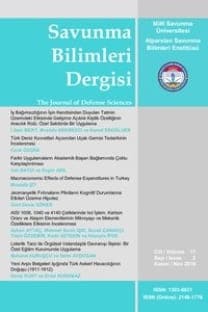Askerî Sistemlerde Nanoakışkan Uygulamalarının Sayısal İncelemesi
Öz
Bu çalışmada; askerî sistemlerin gelişen teknolojiye
bağlı olarak artan ısıl yük problemini çözmek maksadıyla, nanoakışkanların
çarpan akışkan jet tekniği ile kullanılarak, yüksek ısı akılı bir yüzeyden olan
ısı transferinin iyileştirilmesi sayısal olarak incelenmiştir. Farklı Reynolds
sayıları (Re=2000, 4000, 6000, 8000) ve farklı tipte hazırlanan
nanoakışkanların (Cu-H2O, CuO-H2O, TiO2-H2O,
Al2O3-H2O) ısı transferine etkisi bu çalışmada
kullanılan parametrelerdir. Çalışmada düşük Reynolds sayılı k-ε türbülans
modeli kullanılmıştır. Sonuç olarak; Re sayısı arttıkça yerel Nu sayısının
arttığı görülmüştür. Cu-H2O nanoakışkanı için (20 nm parçacık
çapında, % 4 hacimsel oranda) Re sayısı 4000-8000 aralığında artırıldığında Nuort
sayısında %47,2’lik bir artış elde edilebildiği tespit edilmiştir. Cu-H2O
nanoakışkanı kullanılması durumunda, ortalama Nusselt sayısında sırasıyla CuO-H2O,
TiO2-H2O, Al2O3-H2O ve
saf suya göre %2,6, %5,5, %6,1, %9,6 iyileşme olduğu görülmüştür. Sayısal
modelde kullanılan düşük Reynolds sayılı k-ε türbülans modelinin sıcaklık
dağılımını ve akış özelliklerini oldukça iyi bir şekilde temsil edebildiği
görülmüştür.
Anahtar Kelimeler:
Biyolojik sistemler, Çarpan Akışkan Jet, Isı Transferi, Nanoakışkanlar
Numerical Investigation of Nanofluid Applications in Military System
Abstract
In this study, enhancement of heat transfer from high
heat flux surface was investigated numerically by using nanofluids and
impinging jet technique to solve the problem of increasing heat loads which is
caused by developing technologies of military sistems. Effect of different
Reynolds number (Re=2000, 4000, 6000, 8000) and different type of nanofluids
(Cu-H2O, CuO-H2O, TiO2-H2O, Al2O3-H2O) on heat transfer are the parameters of
this study. Low Re k-ε model was used. It was obtained that increasing Re
number causes an increase on local Nusselt number. Increasing Reynolds number
from 4000 to 8000 causes an increase of 47.2% on average Nusselt number for
Cu-H2O nanofluids (particle diameter of 20 nm and volume ratio of 4%). It was
determined that using Cu-H2O nanofluid causes an increase of 2.6%, 5.5%, 6.1%
and 9.6% on average Nusselt number with respect to CuO-H2O, TiO2-H2O, Al2O3-H2O
and pure water. It was seen that the low Reynolds number k-ε turbulence model
well represents the temperature distribution and flow properties at this study.
Keywords:
Biosystems, impinging jets, Heat Transfer, Nanofluids,
___
- Kaynakça
- Makaleler
- Corcione, M. (2011). Empirical correlating quations for predicting the effective thermal conductivity and dynamic viscosity of nanofluids, Energy Conversation Management, 52 (1), 789-93. Dilibal, S., (2016). Nikel-Titanyum ile biyo-ilham robotik parmak ve gripper sistemleri, Kontrol/İTÜ, 10, 16-17. Isman, M. K., Pulat, E., Etemoglu, A. B., ve Can, M.(2008). Numerical investigation of turbulent impinging jet cooling of a constant heat flux surface, Numerical Heat Transfer, 53(10),1109-1132. Kang, S.W., Wei, W.C., Tsia, S.H. ve Yang S.H. (2006). Experimental investigation of silver nanofluid on heat pipe thermal performance, Applied Thermal Engineering, 26, 2377-2382. Kilic, M., Çalışır, T. ve Başkaya, Ş. (2017). Experimental and numerical study of heat transfer from a heated flat plate in a rectangular channel with an impinging Jet, Journal of the Brazilian Society of Mechanical Sciences and Engineering, 39(1), 329-344. Kilic, M. ve Baskaya Ş. (2017). Improvement of heat transfer from high heat flux surfaces by using vortex promoters with different geometries and impinging jets, Journal of the Faculty of Engineering and Architecture of Gazi University, 32(3), 693-707. Li, C., Zhou J. (2007). Experimental and numerical simulation study of heat transfer due to confined impinging circular jet, Chemical Engineering Technology, 30 (10), 1355-1361. Li, Q., Xuan, Y. ve Yu, F. (2012). Experimental investigation of submerged single jet impingement using Cu-water nanofluid, Applied Thermal Engineering, 36(1), 426–433. Manca, O., Ricci, D., Nardini, S. ve Lorenzo, G. (2016). Thermal and Fluid Dynamics Behaviours of Confined Laminar Impinging Slot Jets with Nanofluids, International Communications in Heat and Mass Transfer, 70, 15-26. McGuinn, A., Persoons, T., O’donovan, T. ve Murray, D. (2007). Surface heat transfer from an impinging synthetic air jet, International Journal of Heat and Mass Transfer, 20, 1333-1338. Qu, J., Wu, H.Y. ve Cheng, P. (2010). Thermal performance of an oscillating heat pipe with Al2O3-Water nanofluids, International Communication Heat and Mass Transfer, 37, 111-115. Shang, F.M., Liu, D.Y., Xian, H.Z., Yang, Y.P. ve Du, X.Z. (2007). Flow and heat transfer characteristics of different forms of nanameter particles in oscillating heat pipe, Journal of Chemical Industry, 58, 2200-2204. Sun, B., Qu, Y. ve Yang, D. (2016). Heat transfer of single impinging jet with Cu nanofluids, Applied Thermal Engineering, 102, 701-707. Teamah, M.A., Dawood, M.M., ve Shehata, A. (2015). Numerical and experimental investigation of flow structure and behavior of Nanofluids flow impingement on horizontal flat plate”, Experimental Thermal and Fluid Science, 74, 235-246. Umer, A., Naveed, S. ve Ramzan, N.,(2015). Experimental study of laminar forced convection heat transfer of deionized water based copper (I) oxide nanofluids in tube with constant wall heat flux, Heat Mass Transfer, 52, 2015-2025. Yan, W.M., Liu, H.C., Soong, C.Y. ve Yang, W.J. (2005). Experimental study of impinging heat transfer along rib-roughened walls by using transient liquid crystal technique, Heat and Mass Transfer, 48, 2420-2428.
- Yayınlanmış Bildiri Metinleri
- Chien, H.T., Tsia, C.Y., Chen, P.H. ve Chen, P.Y. (2003). Improvement on thermal performance of a disc-shape miniature heat pipe with nanofluid, Proceedings of the fifth International Conference on Electric Packaging Technology, (IEEE), 389-391. Kilic, M. ve Ozcan, O. (2017) Numerical Investigation of heat transfer and fluid flow of nanofluids with impinging jets, Proceedings of the International Conference On Advances and Innovations in Engineering (ICAIE), 434-440.
- ISSN: 1303-6831
- Yayın Aralığı: Yılda 2 Sayı
- Başlangıç: 2002
- Yayıncı: Milli Savunma Üniversitesi Alparslan Savunma Bilimleri ve Millî Güvenlik Enstitüsü
